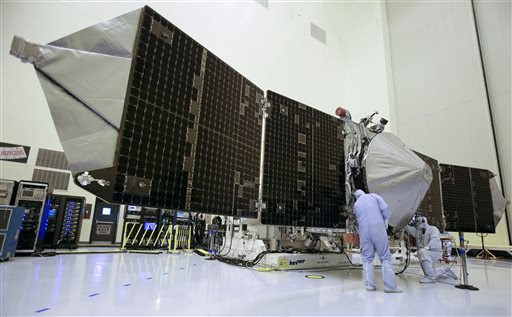NASA’s Maven spacecraft reaches Mars this weekend

In this Friday, Sept. 27, 2013 file photo, technicians work on NASA’s next Mars-bound spacecraft, the Mars Atmosphere and Volatile Evolution (MAVEN), at the Kennedy Space Center in Cape Canaveral, Fla. NASA’s Maven spacecraft will reach the red planet in September 2014 following a 10-month journey spanning more than 440 million miles. If all goes well, Maven will hit the brakes and slip into Martian orbit Sunday, Sept. 21, 2014. AP
CAPE CANAVERAL, Florida — Mars, get ready for another visitor or two. This weekend, NASA’s Maven spacecraft will reach the red planet following a 10-month journey spanning 442 million miles (711 million kilometers).
If all goes well, the robotic explorer will hit the brakes and slip into Martian orbit Sunday night.
“I’m all on pins and needles. This is a critical event,” NASA’s director of planetary science, Jim Green, said Wednesday.
Maven is not designed to land; rather, it will study Mars’ upper atmosphere from orbit.
Hot on Maven’s heels is India’s first interplanetary spacecraft, Mangalyaan, which is due to go into orbit around Mars two days after Maven.
Article continues after this advertisementScientists want to learn how Mars went from a warm, wet world that may have harbored microbial life during its first billion years, to the cold, barren place of today. Maven should help explain the atmospheric changes that led to this radical climate change.
Article continues after this advertisement“Where did the water go? Where did the CO2 go from that early environment?” said chief investigator Bruce Jakosky of the University of Colorado’s Laboratory for Atmospheric and Space Physics in Boulder.
These escaping gases likely went down into the Martian crust and up into the upper atmosphere and out into space. Jakosky and his team hope to ascertain whether the climatic about-face resulted from the sun’s stripping away of the early atmospheric water and carbon dioxide.
“We measure these things today even though the processes we’re interested in operated billions of years ago,” he said.
NASA launched Maven from Cape Canaveral last November on the $671 million mission, the first dedicated to studying the Martian upper atmosphere. As of Wednesday, the spacecraft was less than 750,000 miles (1.2 million kilometers) from its destination; Maven’s view of the red planet would be roughly equivalent to a baseball about 52 feet (15.8 million meters) away.
“So Mars is really growing right now as we approach, just four days away,” said David Mitchell, NASA project manager.
The boxy, solar-winged craft is as long as a school bus and as hefty as a 5,400-pound (2,450-kilogram) SUV.
NASA expects a scientific bonus from Maven thanks to Comet Siding Spring.
The nucleus of the comet, discovered just last year, will pass within 82,000 miles (132,000 kilometers) of Mars on Oct. 19. NASA initially feared the trailing comet dust might jeopardize Maven, but the risk now appears to be minimal, Jakosky said. The spacecraft will observe Siding Spring, providing it can do so safely, and analyze the Martian atmosphere before and after the comet passes by.
“I’m told the odds of having an approach that close to Mars are about 1 in 1 million years, so it’s really luck that we get the opportunity here,” Jakosky said.
Maven — short for Mars Atmosphere and Volatile Evolution — is a scout for the human explorers whom NASA hopes to send in the decades ahead. It’s NASA’s 21st mission to Mars since the 1960s.
There are three spacecraft now circling Mars — one European and two U.S. — and two NASA rovers exploring the surface.
“For humans to go to Mars, it’s not like ‘Star Trek.’ It’s not like ‘go where no man has gone before,’ ” Green told reporters. “It’s really the planetary scientists that are blazing the trail for us to understand everything about Mars that we need to for humans to be able to land safely on Mars and explore and journey around the planet.”